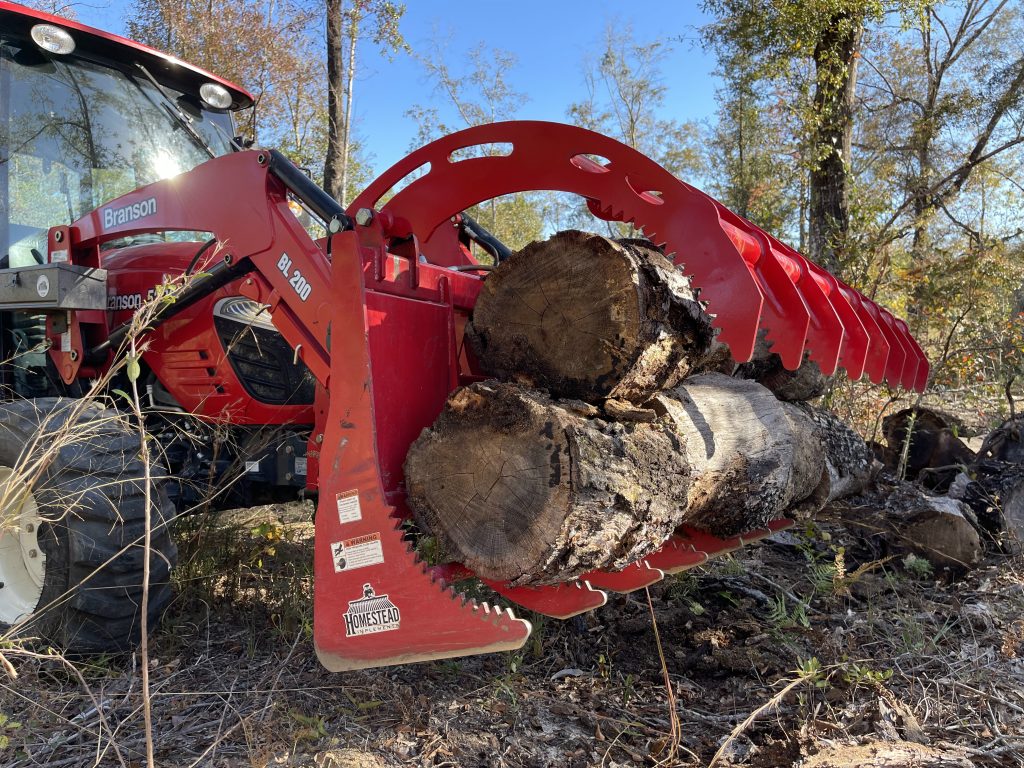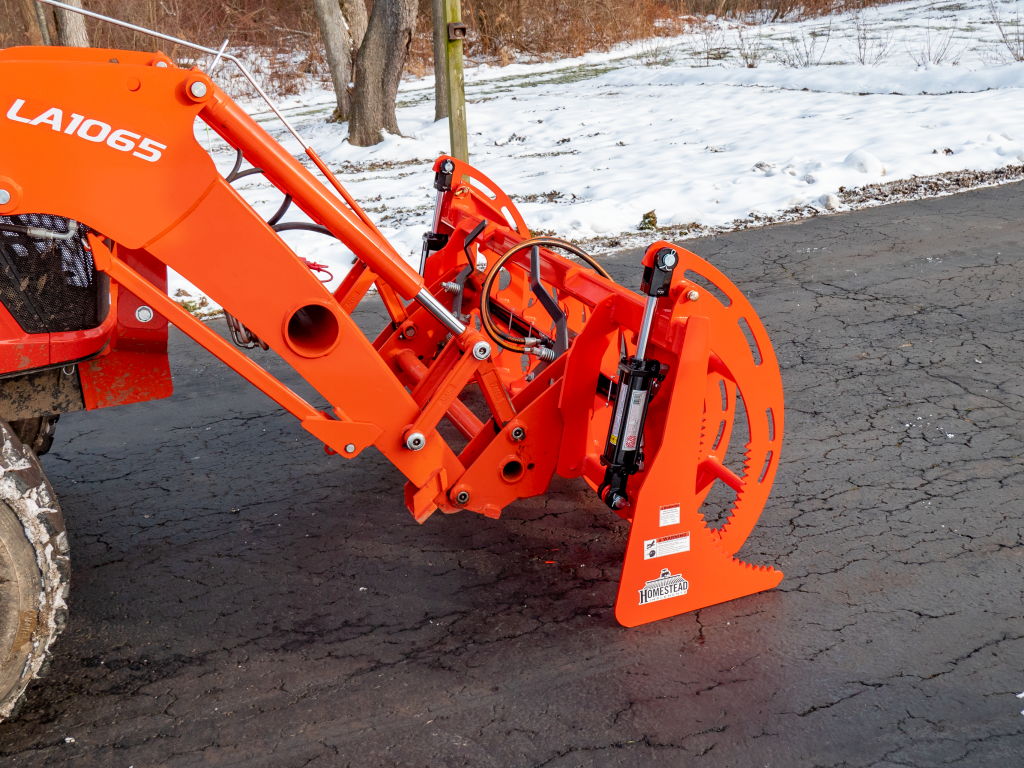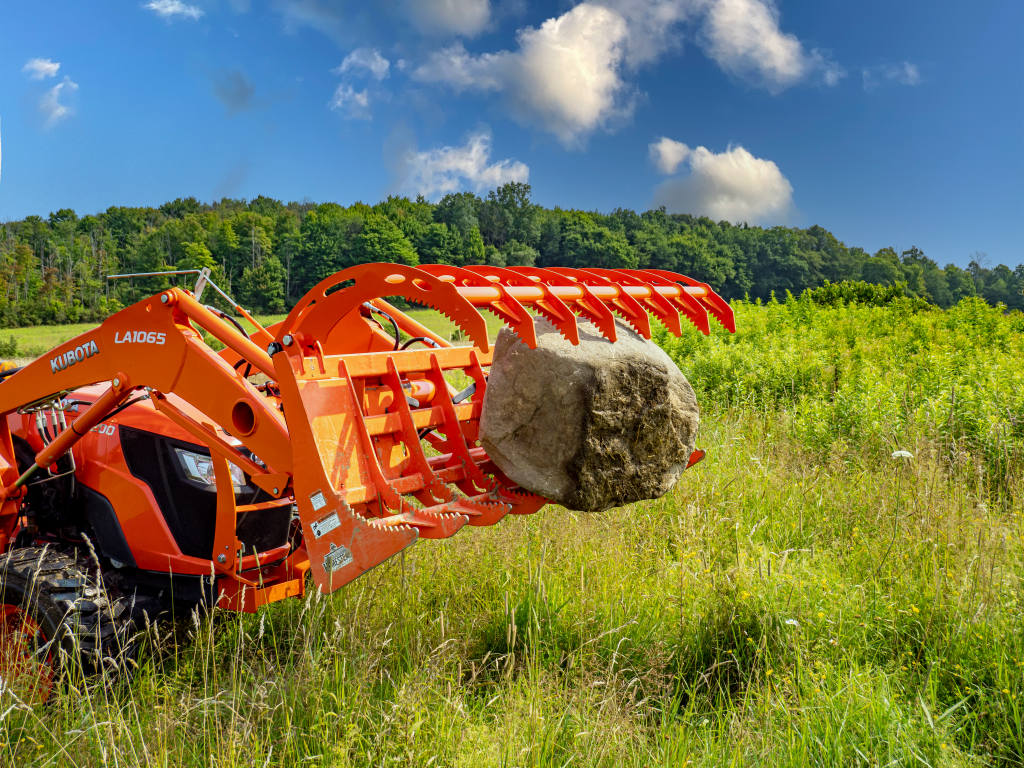Tractor Grapples – The Complete Guide
As a recreational timberland owner, the need to move brush, timber slash, and downed trees is a constant requirement of stewarding my property to its maximum wildlife, economic, and aesthetic potential. No matter what type of land you are managing, a tractor grapple stands as an indispensable tool, making work more efficient, safer, and less strenuous. These highly versatile attachments are designed to grip, lift, and transport a variety of materials in different environments. As with every tractor component, attachment, and implement it is important that you understand the styles, types, uses, and features that are available to you. In this guide, we will do just that, as well as help you determine which choice is right for your needs.
Tractor Grapple Attachment Styles
Different tasks and materials require distinct tractor grapple attachment styles. Understanding the variations can help ensure you select the one that best meets your needs. Getting the wrong style can make your work frustrating and inefficient, not to mention cost you more money over the long term. Get the right style and you may find this to be the most useful attachment you own.
Tractor Root Grapple and Tractor Brush Grapples
A tractor root grapple and a brush grapple for tractors are two different names for essentially the same thing. While there are variations in designs, these grapples are at their best when clearing debris like roots, branches, and other scattered vegetation. They are also suitable for rocks and other loose materials. They are usually built with hydraulic claws that allow a wide range of motion, with tine spacing allowing dirt to fall through while holding onto the larger material.

Tractor Pallet Fork Grapple
This type features a set of pallet forks with a grapple arm. They are designed for transporting palletized items securely, particularly useful when dealing with unstable or irregularly shaped loads that require additional support to prevent tipping.
Tractor Grapple Bucket
Essentially a standard loader bucket with a grapple claw mechanism on the top, these attachments are great for moving a mix of materials, such as soil and debris. Their enclosed structure makes them ideal for carrying loose or small materials without spillage. They are typically most useful in environments where materials are being moved on flat surfaces like concrete.
Tractor Grapple Attachment Types
Along with the various styles of tractor grapples, there are also different types of opening and closing mechanisms that you may choose depending on the type of front-end loader you currently have.
Hydraulic Grapple
Hydraulic tractor grapples have several key advantages over their mechanical and electric counterparts. Hydraulic systems use fluid pressure to generate a significant amount of force, making hydraulic grapples particularly effective for handling heavy and large materials. They offer greater lifting and holding capacities as well as excellent control over the opening, closing, and pressure of the grapple, which can be fine-tuned to handle delicate tasks. This level of control can be crucial for preventing damage to the grapple, tractor, or material being handled.
Hydraulic grapples can be utilized in a wide range of tasks from clearing debris, logging, and handling scrap materials to construction applications. They are available in a variety of sizes and styles, which can be customized to specific tasks. Hydraulic grapples are robust and resilient, capable of functioning reliably in diverse weather conditions, including cold and wet environments where electric grapples may encounter issues. Hydraulic systems, due to their construction and operating principle, often have a longer lifespan than mechanical or electric grapples. They can withstand the demands of heavy-duty operations for extended periods. Overall, Hydraulic grapples are the most common type you will encounter and will give you the widest range of options in style, design, and function.

Mechanical Grapple
Mechanical grapples operate using simple mechanical systems, typically relying on the dump and curl function of your front-end loader to open and close the jaws of the grapple. This simplicity typically results in a lower upfront cost compared to hydraulic or electric grapples. If your front-end loader does not currently have a 3rd function, you can potentially find an option that will not require you to add a 3rd function valve kit. Mechanical grapples do not risk electrical issues in damp or wet conditions as well as damage to electric cables in harsh environments.
While mechanical grapples have the advantage in terms of lower upfront cost, due to their design, they do not have the lift height operation that hydraulic and electric grapples do, meaning stacking debris or loading it into high-top trailers will be an issue. Additionally, mechanical grapples cannot be fine-tuned for precise work. These types of grapples are generally limited in the scope of the work they can accomplish and are more of a hobbyist / occasional use type of attachment. While the upfront investment may be lower, if you find yourself looking for an upgrade in the future, you may find the resale opportunities for this attachment to be challenging as most tractor owners will be looking for hydraulic options.
Electric Grapple
Electric tractor grapples are a newer technology compared to their hydraulic and mechanical counterparts. Electric grapples usually have fewer moving parts and don’t require fluid changes or checks, reducing the maintenance demand compared to hydraulic systems. As with mechanical grapples, electric grapples do not require a 3rd function on the front-end loader but they may have limitations in extremely wet or dirty conditions, and their lifting and holding capacities may not match those of hydraulic grapples.
Points To Consider In The Best Grapple For Tractor Work
Homestead Implements is an industry leader in the world of tractor grapples and other front-end attachments and 3-point implements. With years of experience under their belt and a commitment to quality, innovation, and making their products in America, they have managed to carve out an excellent reputation for providing robust, efficient, and dependable implements. Their customer-centric approach and dedication to providing excellent service and support ensure users are equipped with the necessary knowledge and tools to optimize their productivity. I recently caught up with Travis Hoyt of Homestead Implements to learn what potential tractor grapple owners need to consider when considering their options.
Compact And Sub Compact Tractor Grapple FAQs
Q: Is there a rule of thumb that you give people as far as grapple weights go?
A: “You want to be as light as possible while still maintaining strength. And the strength comes from different places. It comes from the materials that you use. Our grapple designs have lots of gussets as well as AR 450 steel. It’s a high abrasion resistance, very tough steel, while also having the reinforcements in the right places to make sure that you’re not having issues where if you pick something up and it does happen to slide, it’s not going to bend something.”
Q: Do you need a specific grapple if you are running a sub-compact tractor vs a compact or utility tractor?
A: “We have three different styles of grapples, we have a subcompact grapple, which weighs 190 pounds, with ¼ inch AR 450 steel, and we recommend it for anything under 25 horsepower, and with a lifting capacity of 1000 pounds. For your 40-horsepower tractor, a standard root grapple will be perfect. A 55-inch standard root grapple is 302 pounds, it’s got 5/16 AR 450 steel, reinforced gussets, and the whole nine yards with it, and that’d be perfect for your compact tractors. So at 302 pounds, that’s an immense amount of lifting capacity you still have plus the way that our grapples are designed, it sits very close to where the end of your SSQA is. So if you need to pick something a little heavier up, you can roll it back and tilt it and you won’t be losing that extra capacity.”
Q: How do you determine which style of grapple is right for you?
A: “When you get into rock grapples, grapple buckets, pallet fork grapples, etc. you’re typically using them for a sole purpose. While they’re very good at what they do they’re not as versatile as a root grapple. The name implies that you can use it for ripping up roots, but they have a million and a half other uses that go with them.”
Q: How do you choose the right width?
A: “The width depends on what you’re doing. If you’re in the middle of the woods getting trails cleared out then a root grapple a little bit closer in width to your tractor will be better because it’s more maneuverable. If you’re out in the middle of the open field you can have a little bit wider grapple and it’s not really going to interfere with anything. The biggest thing that we tell people is you want to get as close to the width of your tractor as possible. Typically the width of your bucket is also a good standard.”
Q: One of the things that will shut you down immediately is a busted hydraulic hose. So when somebody’s looking at a grapple, what do they need to look for in terms of the placement of those hoses?
A: “That is a common thing, a lot of people do have sticks or debris that sometimes snag hoses. What we do to prevent that is to run our hoses behind a C channel on the inside of the grapple. And so this C channel actually protects the hoses all the way down along the edges of the grapple. Another thing is sometimes you’ll see that the hoses will rub against the grapple. And they’ll start to chafe and cause issues. We run our hoses in a way that they sweep away from the metal edges so that you won’t have that issue as well. They have a little bit of play so that they can move freely, but they are protected from whatever you’re working on. Another problem with hydraulics can be when you’re hooking up your grapple. On some designs, if you aren’t careful when attaching the implement you can hit these cylinders and bust them up. We design our grapples with metal ears that protect the hydraulic cylinders themselves. So you can just hook up and not worry about hitting the cylinders.”

Q: You guys manufacture your implements in America. What are you getting with an American-made product that you may not be getting from products manufactured overseas?
A: “The biggest thing is American quality, you’re getting true good quality components, workmanship, and service after the sale. All of the steel that we use, we get it from North America. We use Hardox AR 450, it’s higher abrasion resistance steel and we get that from the United States. Everything’s welded, powder coated, and assembled in our facility in Jamestown, New York. You’re getting customer service, you’re talking to a real person, whenever you buy from us, from an American company in general, you get to talk to someone who can relate to you and help you out if you have an issue. Or if you have a question about the equipment or what you can use it for. We’re always there to help you out.”
How To Use A Grapple On A Tractor – Best Practices And Mistakes To Avoid
To ensure maximum effectiveness and longevity of your grapple, it’s vital to adhere to the following best practices and avoid common mistakes that create damage. Before you start, familiarize yourself with the specifications of your tractor and the grapple attachment. Knowing their respective weight limits, load capacities, and operating procedures is crucial for safe and efficient usage. Prior to the operation, check the grapple for any signs of wear and tear or damage. Look out for broken tines, hydraulic leaks, and ensure that all pins and bolts are securely fastened. Regularly maintaining the grapple will ensure it remains in good working condition. This includes greasing the pivot points, inspecting hydraulic lines, and replacing worn-out parts.
When picking up an object, approach it straight on with the grapple tines aligned correctly. Uneven loading can put excessive stress on one side of the grapple, potentially leading to damage. Ensure the load is balanced within the grapple. An unbalanced load can make the tractor unstable and risk tipping over, especially when transporting the load over uneven terrain. Never exceed the load capacity of the grapple or the tractor’s lifting capacity.
Avoid jerky movements while operating the grapple. Smooth and controlled movements help to reduce stress on the grapple, the tractor, and the load. When transporting materials, keep the load as low as possible to maintain a low center of gravity, improving the tractor’s stability. Avoid raking backward with the lid of the grapple, pulling stumps, and pushing over trees. While these are tempting practices to undertake and you may get away with them a time or two, eventually you will face the consequences of repeated abuse. By following these best practices, you can ensure your safety while optimizing the performance and lifespan of your grapple attachment. It’s always a good idea to consult the manufacturer’s manual for specific instructions related to your particular model of tractor and grapple.
Final Thoughts On Tractor Grapples
In the vast landscape of tractor attachments, tractor grapples undoubtedly stand as indispensable tools that dramatically enhance productivity and efficiency. No matter which direction you decide to go, each type and style offers unique benefits that cater to diverse operational needs. Companies like Homestead Implements continue to innovate tractor grapples that address the evolving demands of the industry, but, as we’ve explored, choosing the right grapple is only half the equation. Knowing how to use and maintain it correctly is equally critical. As a tool that truly transforms your daily operations, a tractor grapple is a worthwhile investment that will earn its keep in the long run.




